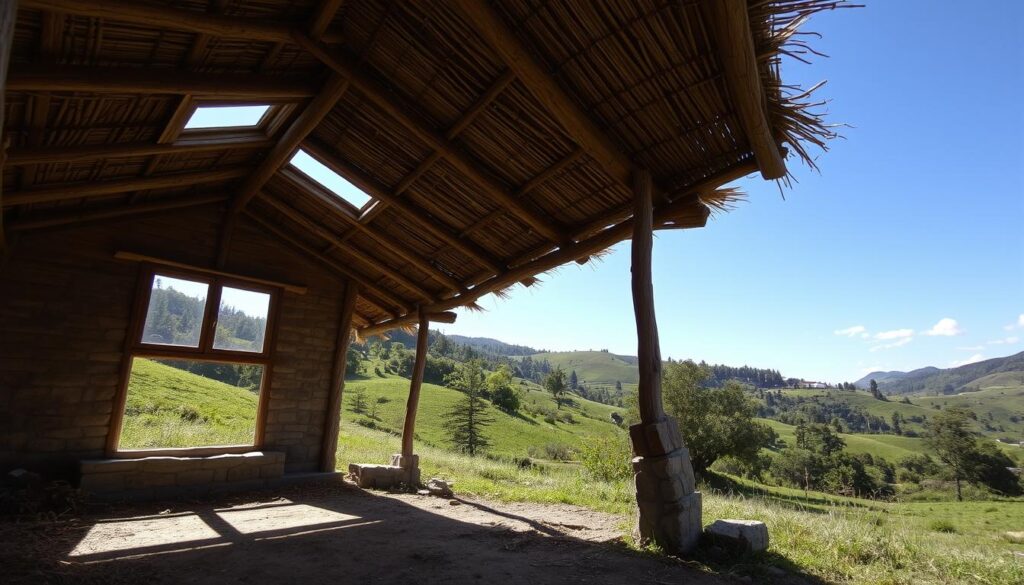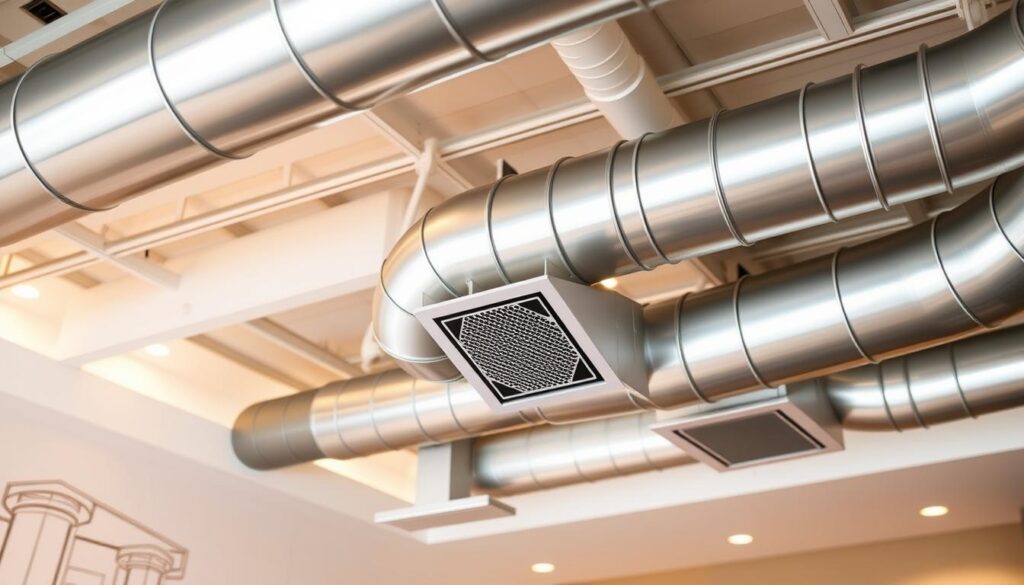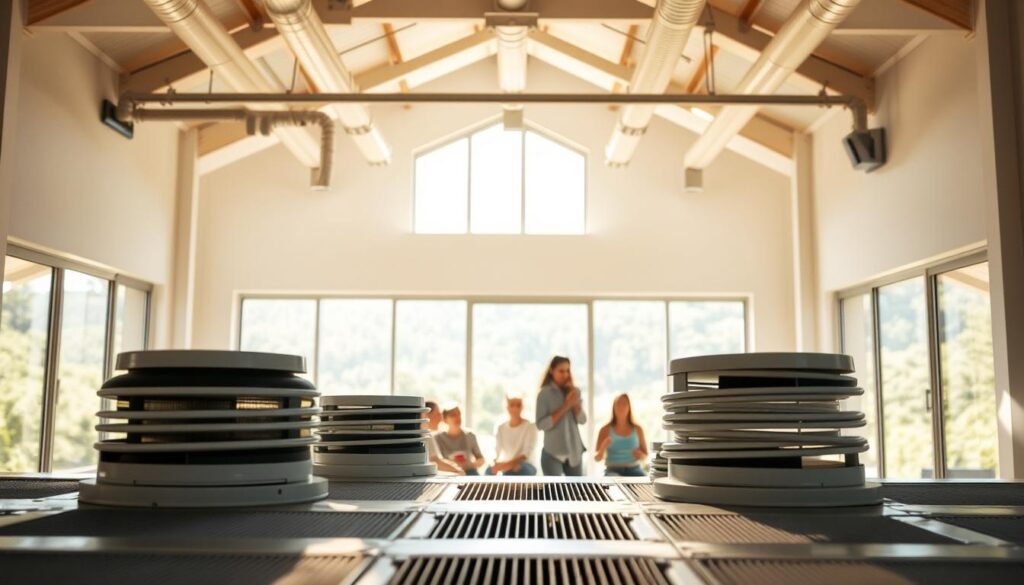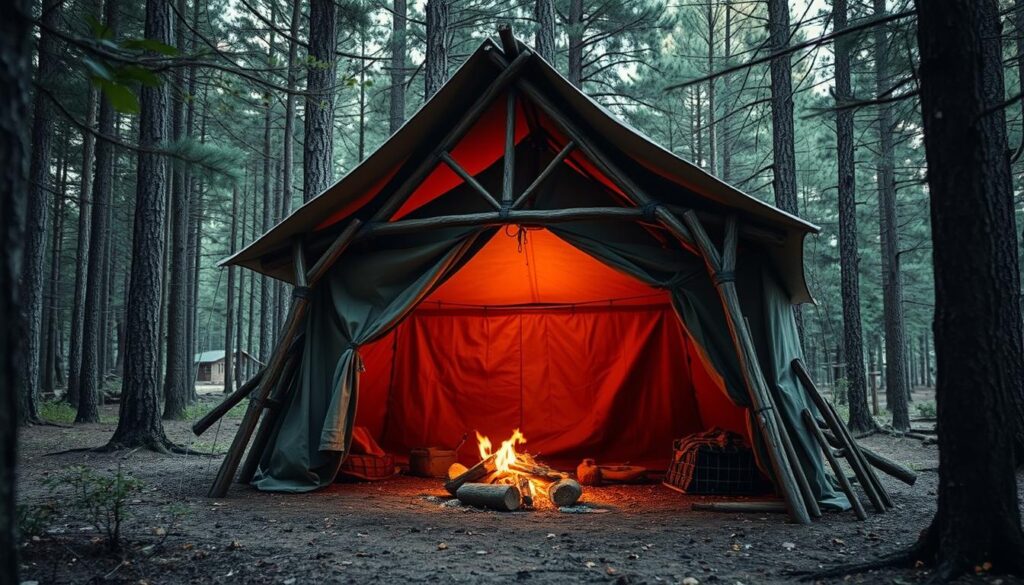I’ve learned how important a clean indoor space is for our health. Indoor air quality is key to feeling good and staying healthy.
Bad air inside can cause headaches, dizziness, and even serious health problems. This is mainly because of too much carbon dioxide.
Good shelter ventilation helps avoid these problems. It makes our homes and shelters safe and healthy places.
Using the right ventilation solutions can greatly improve the air we breathe. This makes our living spaces more comfortable and secure for everyone.
Key Takeaways
- Proper ventilation is essential for maintaining good indoor air quality.
- Poor ventilation can lead to serious health issues.
- Effective ventilation solutions can significantly improve health and comfort.
- A well-maintained indoor environment is vital for our overall well-being.
- Implementing the right ventilation systems can prevent health risks.
Understanding Shelter Ventilation
Knowing the basics of shelter ventilation is key to keeping people safe and healthy. It’s about making sure shelters have enough airflow. This keeps the air inside fresh and comfortable.
What is Shelter Ventilation?
Shelter ventilation uses different methods to get rid of old air and moisture. This makes the air inside better. It can be done naturally or with machines.
For more info on building emergency shelters, check out this step-by-step guide.
Importance of Proper Ventilation
Good ventilation is vital for a healthy shelter. It gets rid of harmful particles and keeps air fresh. This makes shelters more comfortable and safe for everyone.
| Benefits of Proper Ventilation | Description |
|---|---|
| Improved Air Quality | Removal of pollutants and stale air |
| Reduced Moisture | Prevention of mold and mildew growth |
| Increased Comfort | Regulation of temperature and humidity |
Common Misconceptions
Many think ventilation is only needed in extreme weather. But, it’s important in all shelters, no matter the weather outside.
Another myth is that ventilation is the same for all shelters. But, it really depends on the shelter’s design, how many people it holds, and the local weather.
Types of Shelter Ventilation
It’s important to know about different shelter ventilation types for a healthy indoor space. Shelter ventilation isn’t a single solution; it varies based on the shelter’s needs and limits.
Natural Ventilation
Natural ventilation uses air flow to ventilate shelters. It uses windows, doors, and vents to bring in fresh air. This method is energy-saving and works well in mild weather or certain seasons.
But, it relies on the weather and might not work in polluted or very hot areas.

Mechanical Ventilation
Mechanical ventilation uses fans and ducts to move and change air. It’s a controlled way to ventilate, good for many places and conditions.
These systems can meet specific needs, like heating and cooling. They’re great when natural ventilation isn’t enough or practical.
Hybrid Ventilation
Hybrid ventilation mixes natural and mechanical methods. It uses the best of both to improve ventilation.
For instance, it might use natural ventilation in mild weather and mechanical when it’s extreme. This mix can save energy and improve air quality.
In summary, choosing a ventilation type depends on many factors like climate, design, and how many people will use it. Knowing about natural, mechanical, and hybrid ventilation helps create better air quality and comfort in shelters.
The Role of Airflow in Shelters
Airflow is very important in shelters. It helps control temperature and air quality. This makes shelters comfortable and healthy.
How Airflow Affects Temperature
Airflow is key for keeping shelters cool. It lets in cooler air, reducing the need for air conditioning. This makes shelters more comfortable.
Airflow also spreads heat evenly when it’s cold. This keeps shelters warm and cozy. It’s very important in very cold places.
Enhancing Indoor Air Quality
Airflow also improves indoor air quality. Stale air can cause health problems. Airflow helps remove pollutants and keeps air fresh.
To keep air quality good, shelters need good ventilation. This includes vents, windows, and other openings. Keeping these open is important for good airflow.
Designing shelters with airflow in mind makes them better. Whether it’s natural or mechanical, good airflow is essential. It makes shelters healthier and more comfortable.
Design Considerations for Ventilation
Creating a good ventilation system for shelters needs careful thought. We must consider several key factors. A well-designed system is key for a healthy and comfy indoor space.
Factors to Consider When Designing
Several factors are important when designing a ventilation system. Shelter size, occupancy rates, and climate are critical. They help ensure the system works well.
- Shelter size affects the volume of air that needs to be ventilated.
- Occupancy rates influence the amount of air exchange required to maintain indoor air quality.
- Climate dictates the type of ventilation strategy that will be most effective.
A study on ventilation design found that “The size and layout of a building, as well as the number of occupants and the activities being conducted within, all impact the ventilation requirements” (
A Guide to Ventilation Design
).
| Factor | Impact on Ventilation Design | Considerations |
|---|---|---|
| Shelter Size | Affects air volume to be ventilated | Larger shelters require more extensive ventilation systems |
| Occupancy Rates | Influences air exchange rates | Higher occupancy requires more frequent air exchanges |
| Climate | Dictates ventilation strategy | Different climates require different ventilation approaches |
Location and Orientation of Openings
The right placement and orientation of openings are key for good ventilation. Natural ventilation improves by placing windows, doors, and vents right. This takes advantage of wind and temperature differences.

By thinking about these factors and designing the system well, shelters can have better air quality. This makes living there more comfortable for everyone.
Ventilation Strategies for Different Types of Shelters
Different shelters need special ventilation plans for good air quality. The shelter’s type, purpose, and activities inside affect its ventilation needs.
Ventilation in Residential Structures
Homes and apartments need ventilation that balances comfort, energy use, and air quality. A good ventilation system removes moisture, cuts odors, and stops pollutants.
Using both natural and mechanical ventilation is common. Opening windows and using fans helps. Also, heat recovery ventilation (HRV) systems save energy by using outgoing air’s heat.
Ventilation in Commercial Buildings
Commercial places like offices and stores need strong ventilation due to more people and different activities. A good system keeps the air healthy and work-friendly.
These buildings often use mechanical systems for lots of air exchange. Adding air filters is also key to remove pollutants and allergens.
Ventilation in Emergency Shelters
Emergency shelters, like those in disasters, need special ventilation. They must be ready fast and work well in tough conditions.
Emergency shelters must be easy to set up and use. Their ventilation systems must handle extreme weather and humidity.
| Shelter Type | Ventilation Needs | Recommended Strategies |
|---|---|---|
| Residential | Balance comfort and energy efficiency | Natural and mechanical ventilation, HRV systems |
| Commercial | High air exchange rates, pollutant removal | Mechanical ventilation, air filtration systems |
| Emergency | Rapid deployment, operation in harsh conditions | Portable ventilation solutions, temporary systems |
In conclusion, shelters need different ventilation plans for a healthy, comfy inside. Knowing each shelter’s needs helps create effective ventilation solutions.
Assessing Ventilation Needs
I think it’s key to check ventilation needs for a comfy and healthy shelter. To do this right, we need to look at a few important things.
Checking ventilation needs means figuring out how much air moves in and out. It also means knowing how many people live there. This helps us see if the air system is good enough.
Tools for Measuring Air Exchange Rates
To find out air exchange rates, we use a few tools. These include:
- Anemometers, which measure air speed.
- Tracer gas techniques, which track a gas to find air exchange rates.
- CO2 monitors, which show ventilation rates by measuring carbon dioxide levels.

With these tools, we can really know the air exchange rate. This is key to making sure the shelter’s air system works well.
Evaluating Shelter Occupancy
It’s also vital to check how many people live in the shelter. More people mean more need for fresh air and better ventilation.
To figure out shelter occupancy, think about the number of people, how active they are, and how long they stay. This helps us tweak the air system to fit the real needs of those living there.
By looking at air exchange rates and how many people live there, we can decide if the air system is good enough. We can also see if it needs changes or upgrades.
Ventilation and Energy Efficiency
In my experience, making ventilation better can really help save energy in different shelters. Good ventilation improves air quality and also cuts down on energy use.
Reducing Energy Costs with Effective Ventilation
Good ventilation can save a lot of energy by needing less heating and cooling. When a shelter has good airflow, it puts less strain on HVAC systems. This means lower energy bills. Here are some ways to do this:
- Using natural ventilation can cut down on the need for mechanical systems.
- Energy recovery ventilation (ERV) systems help by swapping heat and moisture between inside and outside air.
- Adjusting ventilation based on how many people are inside and the weather outside.
Integrating Ventilation with HVAC Systems
Linking ventilation with HVAC systems is key for top energy efficiency. This link makes sure ventilation matches heating and cooling needs, saving energy. Some good ways to do this include:
- Demand-controlled ventilation (DCV) adjusts ventilation based on how many people are there.
- Hybrid ventilation systems mix natural and mechanical ventilation.
- Keeping HVAC systems in good shape and balanced for better efficiency.
By using these methods, you can cut down energy costs a lot. And you can keep the inside of your shelter healthy and comfy. Ventilation is not just for better air; it’s also a big part of making shelters energy-efficient.
Common Ventilation Issues
Shelter ventilation faces a big challenge: common ventilation problems. These issues can cause stale air, moisture, and pollutants to build up. This harms the health and comfort of those inside.
Identifying Poor Ventilation Signs
Spotting signs of poor ventilation is key to better air inside. Look for condensation on windows, mold on walls, and a musty smell. People might also get sick more often because of bad air.
Solutions for Inadequate Ventilation
To fix poor ventilation, find out why it’s happening. Check the ventilation system for blockages or damage. Also, look at the shelter’s design to see if it lets in enough air.
Improving Ventilation: Simple steps can help a lot. Open windows, use fans, or get a better ventilation system. Keeping the system clean is also important to avoid dust and debris.
- Regularly check the ventilation system.
- Make sure vents and ducts are clear.
- Think about getting a hybrid ventilation system for better performance.
By tackling common ventilation problems, shelters can become healthier and more comfortable places.
Maintenance of Ventilation Systems
To keep ventilation systems working well, regular maintenance is essential. Proper care boosts efficiency and extends the system’s life.
Regular Checks and Balancing
Regular inspections help spot problems early. Look for wear or damage on fans, filters, and ducts. Balancing ensures even airflow, keeping air quality consistent.
- Inspect fans and motors for unusual noise or vibration.
- Check filters for dust accumulation and replace them as needed.
- Ensure ducts are free from leaks and obstructions.
Cleaning and Upkeep of Ventilation Components
Cleaning is a key part of ventilation maintenance. Filters, coils, and fans need regular cleaning. Ignoring this can lower system performance and raise energy costs.
Here are some cleaning and upkeep tips:
- Clean or replace filters every 1-3 months, depending on usage.
- Inspect and clean coils annually to prevent dirt buildup.
- Schedule annual professional maintenance to inspect and clean the entire system.
Following these maintenance steps ensures your ventilation system works efficiently. This provides a healthier indoor space.
Impact of Climate on Ventilation
Climate greatly affects how much ventilation a place needs. Knowing this helps in making better ventilation systems. Each climate has its own challenges for ventilation, so designs must be flexible.
Adapting Ventilation Strategies for Different Climates
In very hot or cold places, ventilation systems need special designs. In hot areas, systems aim to bring in lots of cool air. In cold places, they try to keep warmth in while also letting in air.
A study on ventilation and air conditioning system design shows the need for climate-specific designs. It proves that making systems fit the local climate can make them work better.
Seasonal Considerations
Seasons also change what ventilation systems need. For example, in summer, buildings need more air to cool down. In winter, they need to keep warm air in.
To show how climate affects ventilation, here’s a table:
| Climate Type | Primary Ventilation Goal | Design Considerations |
|---|---|---|
| Hot and Humid | Maximize cooling through airflow | Large openings for cross-ventilation, shading devices |
| Cold | Minimize heat loss | Insulated ventilation systems, controlled air exchange |
| Temperate | Balance between cooling and heating needs | Adjustable ventilation systems, seasonal adjustments |
By understanding and adapting to these changes, we can make ventilation systems more efficient and effective.
Legal and Regulatory Aspects
Understanding building codes and environmental rules is key for good shelter ventilation. It’s not just about avoiding trouble with the law. It’s also about keeping people healthy and safe.
Building Codes Related to Ventilation
Building codes set the basic rules for ventilation in shelters. They make sure buildings are healthy places to be. For example, they might say how much air needs to flow, where vents should be, and what kind of systems to use.
Key aspects of building codes related to ventilation include:
- Minimum ventilation rates
- Requirements for natural versus mechanical ventilation
- Standards for ventilation system design and installation
Environmental Impact Regulations
Environmental rules also shape how we ventilate. They help buildings use less energy and pollute less. Ventilation systems that care about the planet help make buildings more sustainable.
Some key environmental considerations include:
- Energy consumption of ventilation systems
- Impact of ventilation on indoor air quality and occupant health
- Potential for integrating ventilation systems with renewable energy sources
In summary, knowing and following the law for shelter ventilation is essential. It keeps us out of trouble and makes sure shelters are safe, healthy, and green.
Resources and Tools for Effective Ventilation
To better understand shelter ventilation, many digital tools and educational resources are out there. They help in designing, checking, and making ventilation systems better.
Digital Tools for Design and Assessment
There are many digital tools for designing and checking ventilation systems. For example, computational fluid dynamics (CFD) software can show how air moves and temperatures change in shelters. Autodesk’s CFD and ANSYS are great for designing and analyzing ventilation.
Further Reading and Educational Resources
If you want to learn more, there are educational resources like the American Society of Heating, Refrigerating, and Air-Conditioning Engineers (ASHRAE) guidelines. The U.S. Environmental Protection Agency (EPA) also has resources on indoor air quality. These offer important details on best practices and rules for ventilation.
Using these resources can help you learn more about shelter ventilation. This can make indoor spaces healthier and more comfortable for everyone.
FAQ
What is shelter ventilation, and why is it important?
Shelter ventilation keeps the air inside safe and healthy. It controls air flow between inside and outside. This is key for good air quality, temperature control, and stopping pollutants and moisture buildup.
What are the different types of shelter ventilation?
There are three main types: natural, mechanical, and hybrid ventilation. Natural uses natural air flow. Mechanical uses fans and ducts. Hybrid mixes both.
How does airflow affect temperature regulation in shelters?
Air flow helps regulate temperature. It lets warm air out and cooler air in. This keeps the shelter at a comfortable temperature, cutting down on heating and cooling needs.
What factors should be considered when designing a ventilation system?
Consider shelter size, how many people it holds, the climate, and where and how openings are placed. This ensures the ventilation works well.
How can I assess the ventilation needs of a shelter?
Use tools to measure air flow and check how many people use the shelter. This tells you if the ventilation is enough and where it needs improvement.
Can proper ventilation lead to energy savings?
Yes, it can. Good ventilation means less need for heating and cooling. This saves energy and keeps the shelter comfortable.
What are the common signs of poor ventilation?
Signs include stale smells, condensation on windows, and mold. If you see these, check and improve your ventilation.
How often should ventilation systems be maintained?
Ventilation systems need regular checks and cleaning. Set up a schedule to keep them working well.
How do different climates impact ventilation requirements?
Climate affects ventilation needs. Hot and humid places need cooling and dehumidification. Cold places need heating and moisture control. Adjust ventilation strategies for your climate.
What are the legal and regulatory requirements for ventilation?
Ventilation must follow building codes and environmental rules. These ensure ventilation systems are safe, healthy, and sustainable.
Where can I find resources and tools for designing and assessing ventilation systems?
Look for digital tools, reading materials, and educational resources. They help with learning and give practical advice on ventilation design and assessment.



